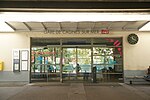Villeneuve-Loubet
Alpes-Maritimes geography stubsCommunes of Alpes-MaritimesPages with French IPAPages with disabled graphs

Villeneuve-Loubet (French pronunciation: [vilnœv lubɛ]; Occitan: Vilanuòva e Lo Lobet; Italian: Villanova Lobetto) is a commune in the Alpes-Maritimes department in the Provence-Alpes-Côte d'Azur region in southeastern France. It lies between Cagnes-sur-Mer and Antibes, at the mouth of the river Loup, ten kilometres west of central Nice. It was created by the joining two old villages: the old village of Villeneuve inland and the village of Loubet on the shore of the Mediterranean Sea. Its inhabitants are called Villeneuvois.
Excerpt from the Wikipedia article Villeneuve-Loubet (License: CC BY-SA 3.0, Authors, Images).Villeneuve-Loubet
Rue des Roches, Grasse
Geographical coordinates (GPS) Address Nearby Places Show on map
Geographical coordinates (GPS)
| Latitude | Longitude |
|---|---|
| N 43.6589 ° | E 7.1222 ° |
Address
Rue des Roches
Rue des Roches
06270 Grasse
Provence-Alpes-Côte d'Azur, France
Open on Google Maps








